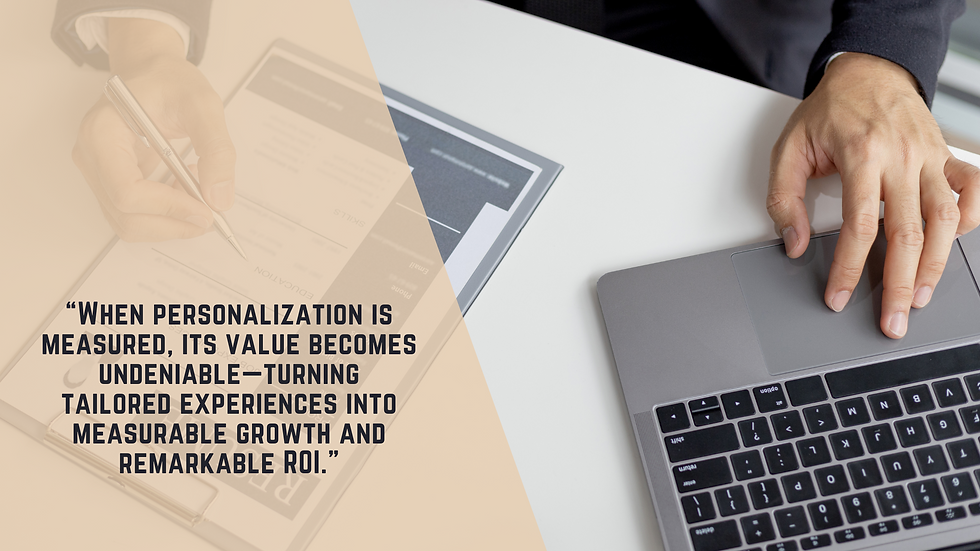How to Use Behavioral Data for Effective Personalization
- Paul Andre De Vera
- Aug 9
- 7 min read
Effective personalization requires real-time behavioral data rather than superficial metrics. Organizations should collect customer interactions across touchpoints, build detailed profiles, and implement dynamic segmentation. AI-powered solutions can analyze patterns and automatically adapt content, leading to increased engagement and ROI. Companies that leverage behavioral data report up to a 667% ROI, 10-20% higher conversion rates, and a 20% improvement in customer satisfaction. The journey to behavior-based personalization transforms customer relationships beyond traditional approaches.
Key Takeaways
Collect real-time behavioral data across multiple channels to build comprehensive, dynamic customer profiles.
Implement AI-powered analytics to identify patterns and predict future behaviors for proactive personalization.
Develop dynamic segmentation strategies that respond promptly to customer interactions, rather than relying on static demographics.
Develop personalized content and recommendations based on recurring behavior patterns and demonstrated preferences.
Establish measurement frameworks with A/B testing to continuously optimize personalization strategies and quantify ROI.
The Limitations of Traditional Personalization Approaches
Although many brands implement personalization strategies, traditional approaches often fail to deliver truly individualized experiences. Most methods rely on superficial metrics, such as page views, creating generic interactions that fail to resonate with customers.
With only 35% of marketers claiming to understand customer behavior, companies struggle to craft meaningful personalized experiences.
Traditional personalization typically employs a one-size-fits-all approach, neglecting individual customer journeys and preferences. The absence of real-time data integration prevents brands from adapting to evolving customer behaviors, resulting in 74% of customers reporting frustration with the irrelevant content they receive.
Understanding the Value of Real-Time Behavioral Data
While traditional personalization strategies rely on static data points, real-time behavioral data fundamentally transforms how brands connect with customers.
Organizations that leverage this dynamic information can tailor customer experiences instantly, increasing satisfaction and engagement.
Real-time personalization yields remarkable results—Netflix attributes 60% of rentals to personalized recommendations.
Companies that monitor customer interactions can detect confusion points and immediately offer targeted support, thereby reducing purchase friction.
The continuous collection of behavioral data enables dynamic profile updates, addressing individual preferences and fostering loyalty.
Personalized marketing campaigns informed by real-time behavioral data significantly improve conversion rates, delivering ROI increases of up to 667%.
Building Comprehensive Customer Profiles Through Data Collection
Organizations can build robust customer profiles by integrating data from multiple sources, including website interactions, purchase history, and customer service engagements.
Ethical consent practices remain essential when collecting this information, necessitating transparent policies and precise opt-in mechanisms that adhere to privacy regulations.
Identifying recurring behavior patterns within this collected data enables businesses to anticipate needs and personalize experiences based on established customer habits.

Multi-Source Data Integration
Three critical streams of customer data—website interactions, email engagements, and mobile app usage—converge in effective multi-source data integration strategies. This fusion creates dynamic customer profiles that evolve in real-time, powering sophisticated personalization initiatives.
First-party and zero-party data combine to form accurate behavioral insights.
Integrated data enables real-time profile updates reflecting the latest interactions.
Predictive analytics anticipate future customer needs when applied to consolidated data.
Enhanced segmentation strategies drive higher conversion rates in marketing campaigns.
The thorough view generated through multi-source data integration transcends individual channel limitations, allowing marketers to craft personalized content that resonates across touchpoints based on extensive behavioral data patterns.
Ethical Consent Practices
The foundation of ethical customer profile development rests on obtaining explicit consent before collecting behavioral data. Research shows 86% of consumers willingly share information when they perceive value in return for their data.
Transparency is critical, with 81% of customers demanding clarity about how their behavioral data is utilized. Organizations that implement intuitive consent mechanisms experience higher engagement rates and greater compliance with regulations like the GDPR.
Zero-party data—information directly provided by customers—strengthens ethical consent practices while enhancing profile accuracy. This approach empowers users to control their data preferences, fostering trust and loyalty while enabling organizations to personalize experiences within appropriate ethical boundaries.
Behavior Pattern Identification
Successful, thorough customer profiling hinges on the systematic identification of behavior patterns across multiple touchpoints. Organizations must analyze digital footprints to decode user behavior patterns that reveal underlying customer needs and preferences.
Distinguishing between new and returning visitors enables the development of tailored engagement strategies.
Analyzing funnel interactions identifies conversion obstacles and optimization opportunities.
Combining structured purchase data with unstructured site interaction metrics creates multidimensional profiles.
Real-time behavioral data integration allows dynamic profile updates for timely personalization.
This extensive approach to behavioral data collection transforms anonymous interactions into personalized customer experiences. By methodically categorizing patterns, businesses can anticipate customer needs, eliminate friction points, and deliver relevant content that resonates with specific customer segments.
Implementing Dynamic Segmentation Strategies
Transforming raw behavioral data into actionable market segments requires sophisticated dynamic segmentation strategies that adapt in real-time to customer interactions.
Organizations implementing these approaches can create highly focused segments that reflect specific actions, yielding 15% revenue increases through targeted messaging.
Advanced analytics tools track cross-channel interactions, allowing businesses to refine segmentation based on evolving consumer behavior continuously.
By incorporating real-time data, marketers can identify high-value customers and trigger personalized communications that greatly enhance loyalty.
Integrating predictive analytics further elevates these strategies by anticipating future behaviors, enabling proactive marketing initiatives aligned with individual customer journeys, and creating a truly responsive personalization framework.
Leveraging AI to Scale Personalized Experiences
How rapidly can businesses scale personalization efforts without sacrificing relevance? Artificial intelligence provides the answer, enabling organizations to transform vast repositories of behavioral data into actionable customer insights at an unprecedented scale.
AI algorithms analyze behavioral patterns to create dynamic customer segments for targeted marketing initiatives.
Predictive analytics anticipate customer needs, facilitating proactive personalized engagement.
Real-time data processing allows for instantaneous content adaptation based on immediate customer interactions.
AI-driven content generation delivers tailored marketing materials automatically, increasing conversion rates.
Companies implementing these AI-powered personalization strategies report significant ROI—up to 667%—by delivering the right message at precisely the right moment, creating experiences that resonate with each customer.
Balancing Personalization With Data Privacy Considerations
While personalization drives impressive business results, organizations must navigate the increasingly complex intersection of customer insights and privacy regulations.
With 79% of consumers concerned about data usage, companies must prioritize transparency in their behavioral data collection practices.
Organizations implementing data anonymization techniques can personalize experiences while protecting sensitive information.
Research shows that companies emphasizing data privacy experience a 76% increase in customer trust, directly enhancing loyalty and engagement.
Regulatory frameworks, such as GDPR and CCPA, mandate explicit consent before utilizing behavioral data.
Forward-thinking brands are leveraging zero-party data—information that customers willingly provide—to create tailored experiences that respect their privacy boundaries.
Measuring the Impact of Behavior-Based Personalization
Evaluating behavior-based personalization requires robust measurement frameworks encompassing key performance indicators, strategic A/B testing, and thorough ROI analysis.
Companies implementing personalized experiences can track metrics such as increased conversion rates (up to 15% according to research), higher customer engagement levels, and a revenue lift compared to non-personalized approaches.
Systematic testing protocols alongside financial impact assessments—which can reveal ROI as high as 667% for real-time personalization—provide organizations with concrete evidence of personalization's effectiveness across different customer segments and interaction points.

Key Performance Indicators
Measurement forms the backbone of any successful personalization strategy. To evaluate the effectiveness of behavior-based personalization, organizations must track specific KPIs that demonstrate a tangible business impact.
Conversion rates typically increase 10-20% with targeted campaigns versus generic approaches.
Customer engagement metrics show personalized emails achieving 18% CTR compared to 2% for non-personalized communications.
Retention rates improve 5-10% when behavioral data drives personalization, enhancing customer lifetime value.
Customer satisfaction scores increase by 20% with personalized experiences.
The return on investment from well-executed personalization strategies can reach up to 667%, confirming the financial wisdom of allocating resources to behavior-based personalization initiatives.
A/B Testing Strategies
A/B testing serves as the gold standard for validating the effectiveness of behavior-based personalization strategies.
Companies implementing this methodology experience conversion improvements of up to 49% through data-driven refinements.
Segmenting test audiences based on behavioral data—such as purchase history and engagement patterns—delivers more targeted insights and enhances content relevance.
Real-time behavioral data integration enables marketers to make swift adjustments to their marketing strategies, promptly addressing customer preferences.
Organizations practicing continuous testing of personalized content report 15-30% revenue growth over time.
This systematic approach to measuring customer engagement creates a feedback loop that sustains optimization efforts and builds competitive advantage through increasingly tailored experiences.
ROI Analysis Framework
The financial impact of behavior-based personalization demands rigorous quantification through structured analysis frameworks. Organizations implementing behavioral data-driven strategies have documented exceptional returns, with real-time personalization yielding up to 667% ROI through tailored customer interactions.
A thorough ROI framework should measure:
Conversion rate improvements (with companies like Amazon attributing 35% of sales to personalized experiences)
Revenue lift from behavioral segmentation (averaging 15% when matching individual customer behavior to relevant products)
Reduction in marketing costs through targeted messaging
Customer loyalty metrics, considering 71% of customers expect personalized experiences
This quantitative approach validates investment while identifying optimization opportunities across the personalization ecosystem.
How BSPK Clienteling Unified Commerce AI Can Help
Ready to transform your customer relationships and drive measurable sales growth? BSPK's AI-powered unified commerce platform puts the proven relationship-building tactics of luxury retail at your fingertips, regardless of your brand size or industry.
Our specialized solution empowers your sales teams with real-time customer insights, personalized product recommendations, and seamless cross-channel data integration, turning every interaction into an opportunity for deeper engagement.
Stop leaving revenue on the table with disconnected systems and generic approaches. Join forward-thinking brands who are already seeing dramatic improvements in customer lifetime value and sales performance.
Schedule your personalized demo today and discover how BSPK can elevate your customer experience while delivering the ROI your business deserves.
Frequently Asked Questions
What Is the Use of Behavioral Data?
Behavioral data provides data-driven insights that power marketing strategies, enhance user experience through personalization, improve customer engagement via targeted content, and enable predictive analytics to anticipate consumer needs and optimize business outcomes effectively.
What Type of Customer Data Is Most Useful for Personalizing Marketing Messages?
Behavioral data, including purchase history, browsing behavior, and engagement patterns, provides the most valuable insights for personalization, surpassing demographic information by revealing actual customer preferences rather than assumed characteristics based on static attributes.
What Are the Two Key Methods of Personalization?
The two primary personalization methods are behavioral segmentation, which facilitates targeted segmentation based on engagement metrics, and dynamic content personalization, which leverages user preferences and predictive analytics to deliver real-time, customized experiences.
How to Analyze Behavioral Data?
Analyzing behavioral data requires robust data collection techniques, practical data visualization tools, and advanced user segmentation strategies. Organizations implement predictive analytics applications and real-time data analysis to transform raw data into actionable insights for informed strategic decision-making.
Conclusion
Behavioral data has transformed personalization by enabling dynamic, contextually relevant experiences that traditional approaches cannot match. Organizations that successfully implement behavior-based strategies—collecting extensive data, segmenting intelligently, and leveraging AI while respecting privacy—gain significant competitive advantages. As personalization technology evolves, companies must continuously refine their approaches, measuring impact and adjusting strategies to meet changing customer expectations and business objectives.




Comments